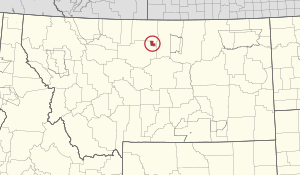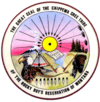Rocky Boy's Indian Reservation facts for kids
Quick facts for kids
Rocky Boy's Indian Reservation
|
||
|---|---|---|
|
||

Location in Montana
|
||
| Tribe | Chippewa Cree | |
| Country | United States | |
| State | Montana | |
| Counties | Chouteau Hill |
|
| Established | September 7, 1916 | |
| Headquarters | Box Elder | |
| Government | ||
| • Body | Business Committee | |
| Area | ||
| • Total | 171.4 sq mi (444 km2) | |
| Population
(2017)
|
||
| • Total | 3,794 | |
| • Density | 22.135/sq mi (8.547/km2) | |
| Website | chippewacree-nsn.gov | |
The Rocky Boy's Indian Reservation is a special area of land set aside for Native American tribes in Montana, USA. It's one of seven such reservations in the state. The reservation was officially created on September 7, 1916. It was named after Chief Ahsiniiwin, whose name meant "Stone Child" but was mistakenly translated as "Rocky Boy."
This reservation was first made for Chippewa (also known as Ojibwe) people who didn't have land in the American West. Later, many Cree and Métis people also came to live there. Today, there are more Cree people than Chippewa on the reservation. The U.S. government recognizes the tribe and reservation as the Chippewa Cree.
You can find the reservation in north-central Montana, in Hill and Chouteau counties. It's about 40 miles (64 km) south of the border with Canada. The reservation covers about 171.4 square miles (444 km²). In 2017, about 3,794 people lived there.
Contents
- About Rocky Boy's Reservation
- A Look at History
- Chippewa Cree Tribal Buffalo Pasture
- Making a Living: Economic Development
- Places of Worship
- Communities on the Reservation
- Weather and Climate
- Important Chippewa and Anishinaabe Leaders
- Important Chippewa-Cree Leaders
- Working for Self-Governance
- See also
About Rocky Boy's Reservation
The Rocky Boy's Indian Reservation is located in the Bears Paw Mountains of north-central Montana. It's the smallest reservation in Montana by land size. In 2010, the population was 3,323, which was a 24% increase from 2000.
The main community on the reservation is Box Elder. The name "Rocky Boy" comes from a mistranslation of Chief Ahsiniiwin's name. His name in the Chippewa language, Asiniweyin, means "Stone Being" or "Being of Stone." The tribe officially recognized on the reservation is the Chippewa-Cree Tribe. These are two distinct groups, the Chippewa and the Cree, who are part of the larger Anishinaabe family of Native American peoples.
A Look at History
Chief Rocky Boy worked hard to get land for his Chippewa people. In 1902, he wrote to the U.S. government, asking for land, homes, and schools for his band of about 130 people. They had been forced out of their original lands and had nowhere to settle. Other landless Native Americans, including a group of Cree, also needed a home.

Chief Rocky Boy worked with important people in Montana, like Senator Joseph M. Dixon and writer Frank Bird Linderman. He lived mostly in north-central Montana. In 1908, a count showed 75 members in his band.
Around this time, there was a sad event called the Swan Valley Massacre of 1908. A small group of Pend d'Oreilles people were hunting, which was their right by treaty. State officials attacked them, leading to deaths on both sides. This event caused anger among Native Americans.
In 1909, over 100 landless Chippewa-Cree from Montana and Idaho gathered. They hoped to move to a new homeland. The government decided to create a new reservation for them, which became the Rocky Boy Reservation. It was first called the Babb Reservation.
Chief Little Bear and about 200 Cree people from Canada also came to the area. They were refugees after a conflict in Canada. The U.S. Army allowed many Chippewa and Cree to settle at Fort Assinniboine in Hill County. By 1912–1913, nearly 600 Chippewa and Cree lived there. The Rocky Boy Reservation was later formed using some land from Fort Assinniboine.
Chief Rocky Boy continued to negotiate for more land, and in 1916, the reservation was officially approved. Soon after, many Chippewa and Cree from different areas settled there. Frank Linderman and other supporters helped the U.S. Congress pass the law to establish the reservation.
Chief Ahsiniiwin explained to government officials that Chippewa people lived all over Montana. He emphasized that his people were peaceful and he spoke only for the Chippewa. He had helped create the Turtle Mountain Indian Reservation and signed an important agreement in Minnesota.
There are different stories about how Chief Rocky Boy passed away in 1916. Some believe he died under suspicious circumstances. After his death, Chief Little Bear became a leader on the new reservation. In 1917, a census was taken to create a list of tribal members for what became the Chippewa Cree Tribe.
Chippewa Cree Tribal Buffalo Pasture
In 2021, the tribe started a buffalo herd on 1,200 acres (4.9 km²) of land. This helps with their culture and provides food. The buffalo, also called bison, live in a fenced area about a mile from Box Elder, Montana. Other tribes and nature groups have donated bison to help the herd grow. In 2022, ten more bison joined the herd.
Making a Living: Economic Development
The Rocky Boy's Reservation has a thriving economy. In 2007, the tribe's yearly income was about $52 million. This money comes from government programs, private businesses, and tribal businesses. Most people on the reservation work for the Chippewa Cree Tribe itself.
The tribe manages its own programs for things like health and community development. They have created several businesses, including:
- Chippewa Cree Community Development Corporation (25 employees)
- Chippewa Cree Construction Company (20 employees)
- Northern Winz Casino (70 employees)
The tribe also runs its own schools, with 184 teachers and staff. They have a tribal college called Stone Child Community College, which employs 57 people. The tribe also provides housing services and health care for its members, employing 135 staff at the Rocky Boy Health Board.
In 2011, the tribe started an online lending company called Plain Green Loans. This company has been criticized by some for offering loans with very high interest rates. The Chippewa Cree are part of a group of tribes involved in online lending.
Northern Winz Casino
The Chippewa Cree Tribe owns and operates the Northern Winz Casino. It opened in 2007 and is located on U.S. Highway 87, about 6 miles (9.7 km) east of Box Elder, Montana.
Chippewa Cree Business Committee
The Business Committee acts as the Tribal Council and governs the tribe. Its members are elected by the community. They serve four-year terms. The tribe has taken over many programs from the Bureau of Indian Affairs (BIA) and Indian Health Service. This gives the tribe more power to make decisions for its people.
Places of Worship
Many people on the reservation are Christian, but some members also follow traditional spiritual beliefs and ceremonies.
- The traditional Thirst Dance, also known as the Sun Dance, happens in early July.
- The annual Pow-Wow is held in early August.
- Other cultural events, like Christmas Dances and round dances, happen throughout the year.
Some Chippewa people have continued their traditions outside the reservation, especially at a place called Hill 57 near Great Falls, Montana. This was led by Mary Chippewa Gopher, who was Chief Rocky Boy's niece.
Several Christian churches are also present on the reservation:
- Our Saviour's Lutheran Church, part of the Evangelical Lutheran Church in America.
- St. Mary's Catholic Church, which was rebuilt after a fire in 2019.
- A Baptist mission church, built in 2002.
- The Rocky Boy Assembly of God Church.
Communities on the Reservation
The Rocky Boy Reservation has nine settlements. Most of these are in the Bear Paw Mountains. Here are some of the main communities:
- Agency (also called "Rocky Boy's Agency")
- Azure
- Boneau
- Box Elder
- Parker School
- Rocky Boy West (also known as New Box Elder)
- Saint Pierre
- Sangrey
There's also a newer settlement about 3 miles (4.8 km) west of Boneau.
Weather and Climate
The Rocky Boy Reservation experiences a variety of weather conditions. Near Box Elder, the summers are warmer due to the lower elevation. Winters can be very windy and cold. Strong winds, called Chinook winds, often occur in winter. These winds can cause snow to melt and sometimes cause damage.
In the Bear Paw Mountains, the Chinook winds are not as strong, but they can still bring warmer temperatures in winter. The mountains also get more snow than the plains.
Here are the average temperatures for Box Elder:
- Winter (December, January, February): Average low temperatures are around 5-9°F (-15 to -13°C). Average high temperatures are around 26-31°F (-3 to -0.5°C).
- Summer (June, July, August): Average low temperatures are around 49-54°F (9-12°C). Average high temperatures are around 76-85°F (24-29°C).
Important Chippewa and Anishinaabe Leaders
- Chief Rocky Boy (Asiniweyin, meaning Stone Being) (c.1852-1916): He was a key leader who helped create the Rocky Boy Indian Reservation. He also helped establish the Turtle Mountain Chippewa Reservation.
- Charles Chippewa: Chief Rocky Boy's brother, who once cared for a special bundle of items belonging to the Chief.
- John Goodrunner: A Chippewa leader who organized the annual Rain Dance (also called Sun Dance) on the reservation.
- Mary Chippewa Gopher ("Iron Claw Bear Woman"): Chief Rocky Boy's niece. She led her people and worked to protect their rights and traditions from 1946 until her death in 1965.
- Mary Bearwalker McGillis: Another important Chippewa woman who helped her people through difficult times.
- Duncan Standing Rock Sr.: An elder who held important ceremonial knowledge and cared for Chief Rocky Boy's sacred bundle until his death in 2021.
- Robert Gopher ("Listening Thunder"): Chief Rocky Boy's grand-nephew, who continued the Chippewa people's efforts to regain their self-governance.
Important Chippewa-Cree Leaders
- Black Powder (c.1800-1865): An Ojibwa leader from the Montana, Alberta, and Saskatchewan regions.
- Big Bear (1825-c.1888): A Plains Cree leader who was involved in the 1885 North-West Rebellion in Canada.
- Little Bear (c.1850-1921): The son of Big Bear. He was a Cree leader who fought in the 1885 North-West Rebellion in Canada. After the conflict, he came to Montana as a refugee. He later followed Chief Rocky Boy to the new reservation and became a leader after Rocky Boy's death.
Working for Self-Governance
In recent years, some members of the Rocky Boy Band of Chippewa have been working to strengthen their self-governance. There were concerns about how the reservation was being managed. The Chippewa people are working to make sure their voices are heard in tribal elections and enrollment processes. They are focused on restoring their right to govern themselves.
See also
- Fort Assinniboine
- List of Indian reservations in the United States
- Bear Paw Ski Bowl



